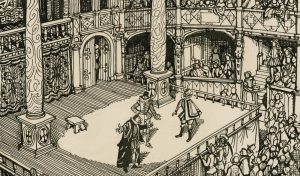
What can historical documents like Philip Henslowe’s diary tell us about the experience of
(a) performing
Actors’ experience of performing in early modern plays is in some ways incomparable to the experience of actors today. With senior actors forming theatre companies and performing exclusively for this company – which they had a financial interest in, receiving shares of the profits from each play – the instability of freelance actors today was only experienced by young or unestablished actors hired only for walk-on parts in the final few days before performances. This company structure meant that actors were always working with the same people, and likely playing the same parts/types of parts due to typecasting – Shakespeare often did not even name his characters, instead using their generic type, such as ‘Fool’, as their identifier in speech prefixes – with Stern explaining that modern editors “discover” the characters’ names for publication today, as modern readers have novelistic expectations (65). Stern also suggests that type casting lead to “Less need for any actor to work on issues of characterisation” (65), as actors essentially played themselves.
Actors – or at least those who weren’t sharers in the company – were also trusted less, and therefore only given cue scripts with their lines and cue lines, and did not receive a full playtext. This was to ensure that were unable to sell the script to publishers for their own profit, rather than that of the company. This also meant, however, that the actors did not know the full plot of the play before performances,which inevitably affected their performances. The celebrated style of acting in the early modern period was therefore very different to that which wins awards today, with actors focussing purely on the emotions displayed within their lines – for example, through the dialogue switching from prose to verse. This is what actors would focus on in sessions with their instructors – more senior actors or in the case of the most established actors, such as Richard Burbage, the playwright himself who help them – when practicing their parts. This process of instruction, though, was often dictatorial – the focus was on showing the emotions, not discussing or understanding them. As Stern’s Stage Traffic states, it was in this way that “‘Correct’ action and gestures continued to be taught for the next two centuries”[p.83], and the ’passions’ these evoked were thus passed on & repeated to become characteristic of that part.
Early modern rehearsal practices, then, were very different to those of today. There were no extensive group rehearsals – only one before performance night at a push. It is almost unimaginable that this would be the cas today, except for specifically billed ‘24 hour plays’.
This was evidently in contrast to the way plays are treated in contemporary production companies today, where they are taken on tour for months and intensely rehearsed in a group dynamic.
(b) being in the audience of an early modern play?
The theatre today is considered as a high-brow, formal institution, which differs from early modern theatre. As we can see from Philip Henslow’s diary, the theatre was cheap, so accessible to the lower classes. It was mass-produced entertainment, so less exclusive. There was the option to stand for the whole show, which would have been cheaper. Theatre was the main source of entertainment, so spectators would expect lots of variety and different plays everyday. Philip Henslow’s diary shows this, as everyday different plays were shown. There was also less etiquette in the theatre. For example, audience members would leave once the main character died, even if the play wasn’t over
Philip Henslowe’s Diary
This historical document belonged to the owner/founder of the Rose Theatre in early modern London, and lists the dates, frequency and profits of the plays shown there. It also includes lists of props and costumes owned by theatre, and records of payments to actors and writers. This is valuable in not only showing the development of acting as an official/professional form of income, but also suggests that other contributors to the theatre experience existed offstage such as costume design, which was most likely done by women at the time.
(c) What strikes you as the most unusual aspect of the theatre from this period?
The most unusual aspect of the theater from this period is the lack of full rehearsals prior to performing the play. This would have resulted in a performance that felt disjointed in comparison to the way we experience live theater today. The lack of full rehearsals would also have resulted in a play that wasn’t as cohesive as plays today – the play would feel, to a modern audience, more like a series of separate people reading parts.
Phoebe, Holly, El, Charlotte, Pearl
